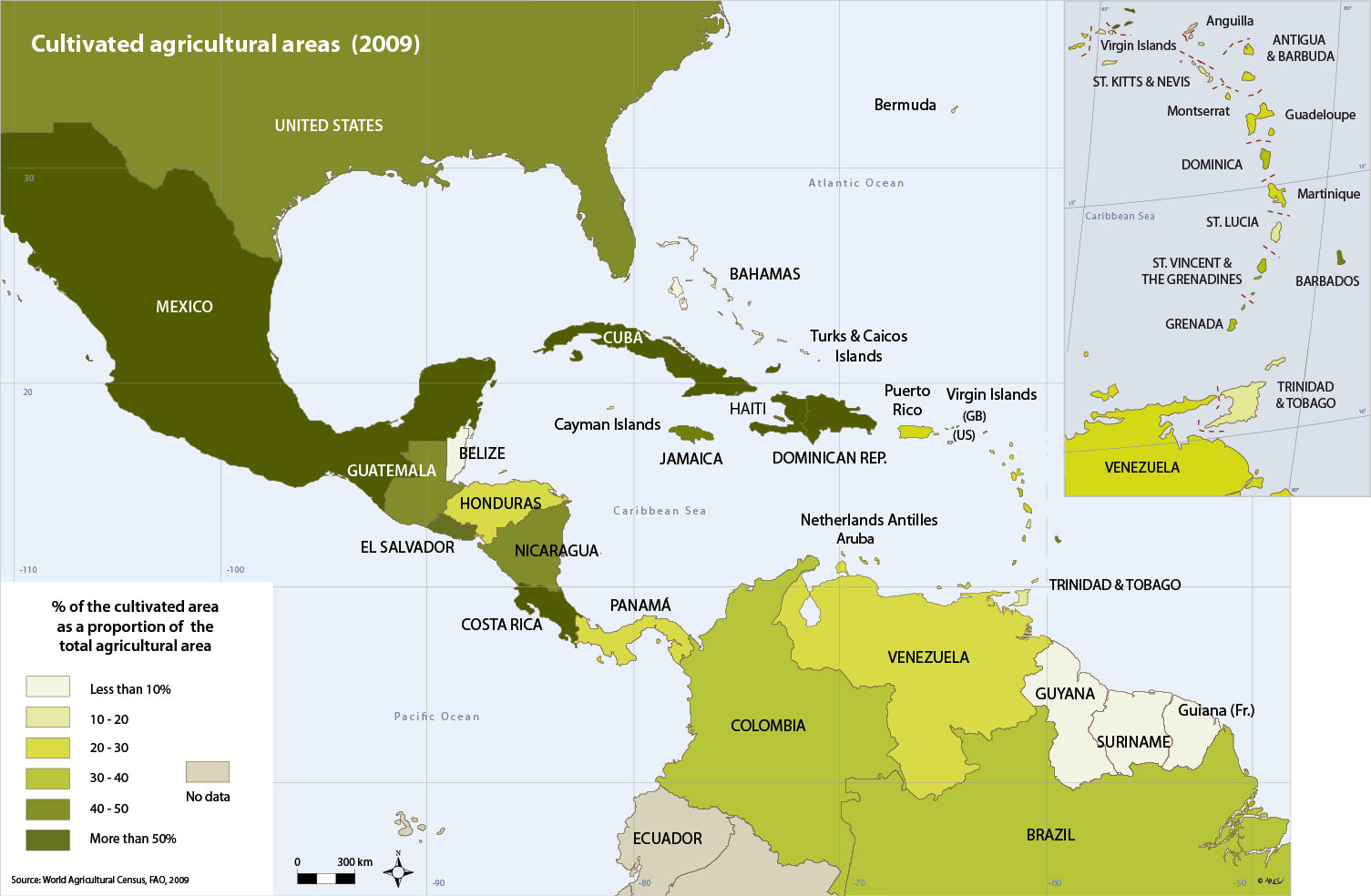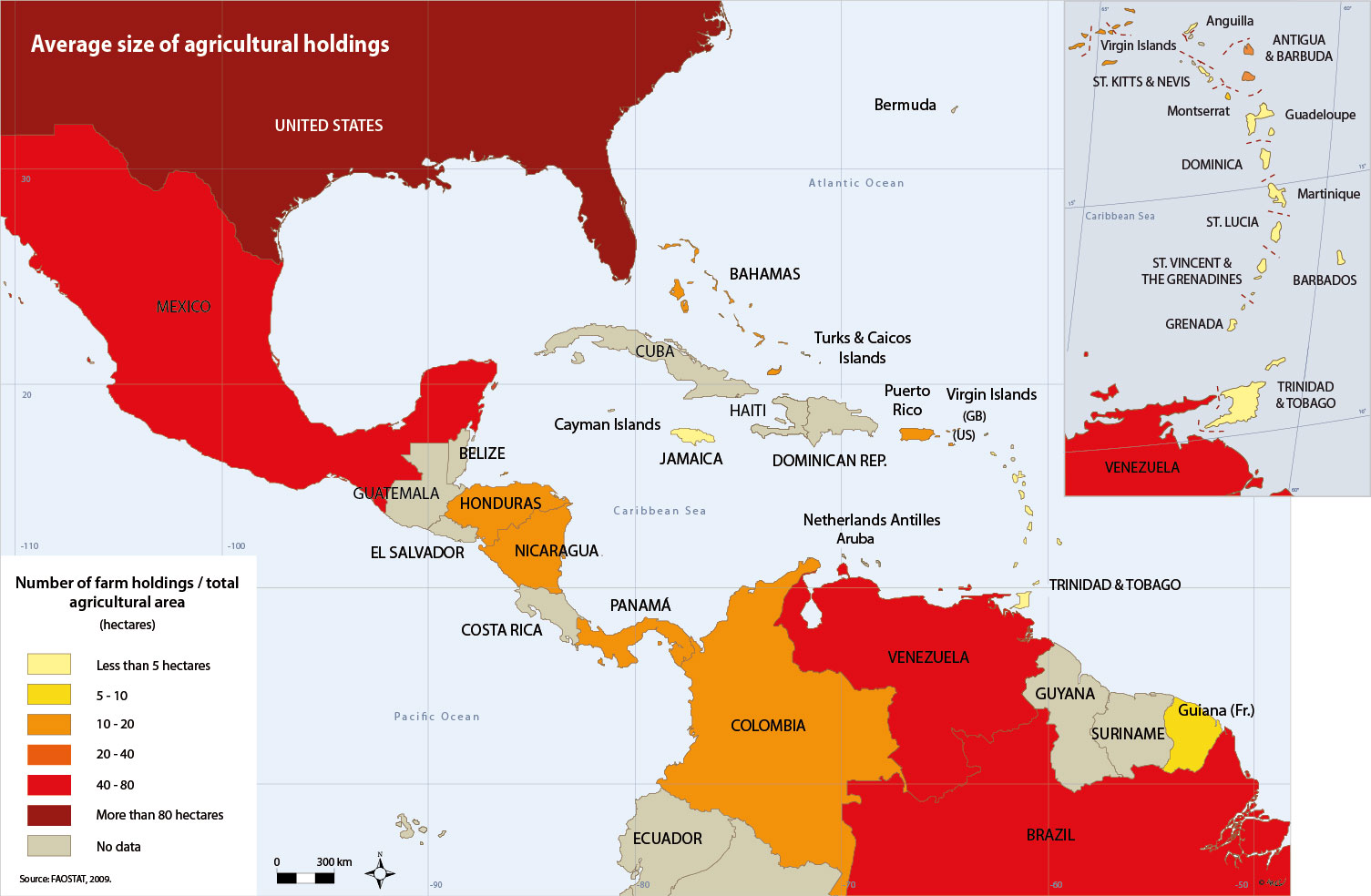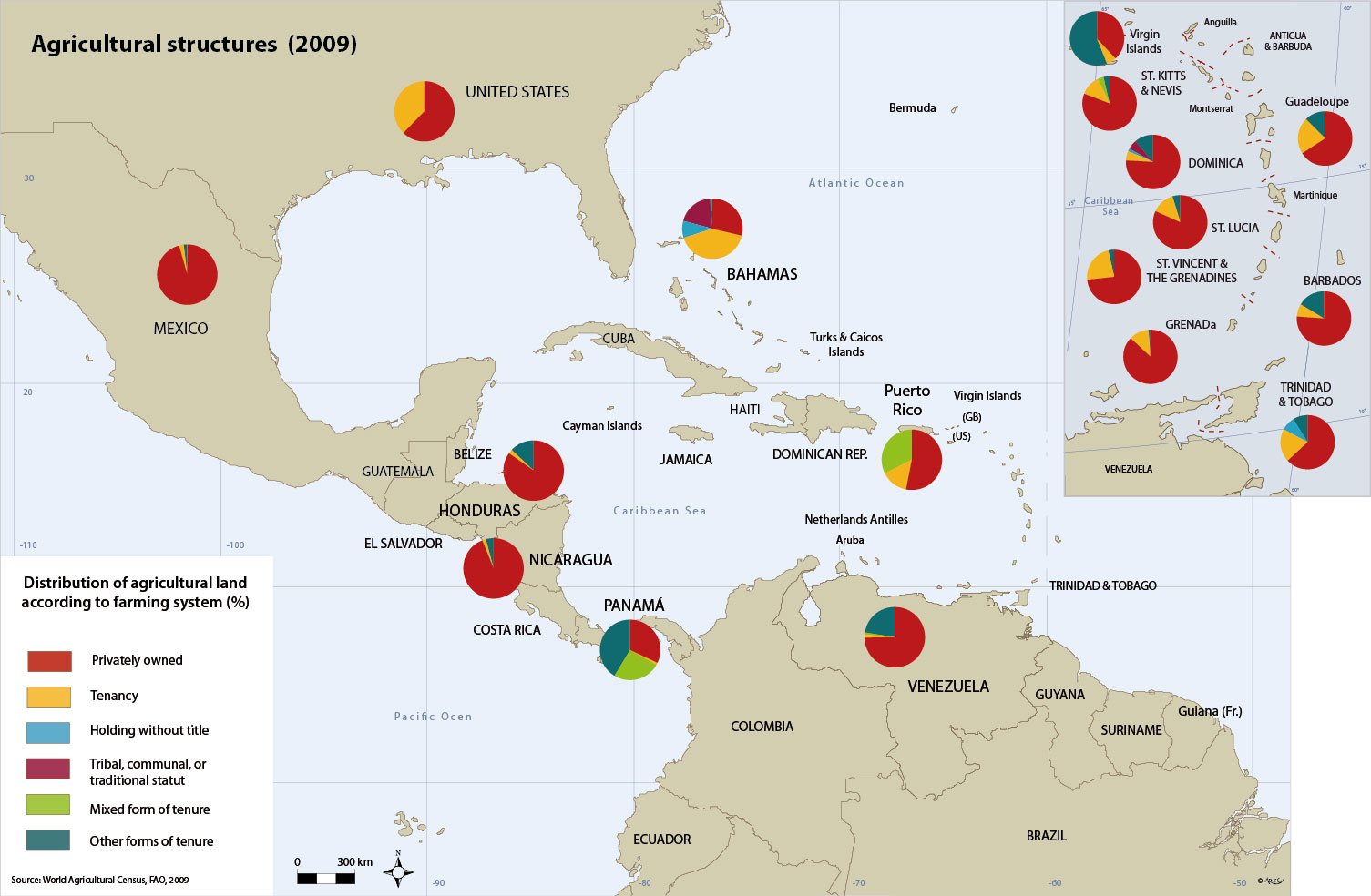
- Agriculture (2006-2009)
- Agriculture : mutation (2005-2006) FR ES
- Agriculture: emblematic landscapes
- Agriculture: food-self sufficiency (2005-2007)
- Agriculture: production (2007-2008)
- Commerce extérieur (2001) FR
- Currencies
- Economic organisations (2009)
- Fishing (1995)
- GNP per capita (1995)
- Integrated energy strategy (2004-2007)
- La Chine dans la Caraïbe FR
- La pêche dans le bassin Caraïbe - 2019 FR
- Le bassin caribéen, théâtre affirmé d'une guerre d'influence sino-étasunienne ? FR
- Nouveau contexte pétrolier (2015) FR
- Nouvelles donnes régionales (2004-2006) FR
- Sugar and Oil (1999-2011)
- Tax havens (2007-2010)
- Tax havens (2008-2012)
Caribbean agriculture reveals a distinctive overall imprint of great diversity. To the production of bananas, coffee and sugar cane can be added citrus fruit, tropical fruits, stock rearing for beef, goats and sheep, as well as cereal cultivation specific to the region.
The land and the agrarian structures contribute to the region's rich make-up both in terms of culture and landscape. The diverse environments are often constraining as seen in the opposition between mainland-space and island-space with various national histories influencing directions in agricultural policy, differences becoming more evident as the inherent problems persist. Shortage of land, management of water resources, protection of the forest cover, so crucial in a region subject to regular cyclonic storms, and maintaining an adequate agricultural population, are all part of a list of issues requiring investigation in order to determine the future stakes facing an agricultural sector so essential to the Caribbean region.
Globalisation has revealed its limits, especially where it concerns small ‘extravert' economies. Blockages whether social (an island economy is easily paralysed as seen in Guadeloupe and Martinique in February 2009), climate-linked or economic (a slow-down in the market), all demonstrate that producing enough to feed one's own population remains an imperious necessity.
In such changing contexts, the emergence of a regional market becomes the real challenge in years to come.
Too little usable agricultural land
Even if a few countries can boast significant of significant percentages, as in the case of Cuba with over 60% of its land area usable agriculturally or El Salvador (75%), others are less well endowed, like Antigua and Barbuda with less than 10% or even Belize which is able to devote only 6% of its land area to agriculture. However, potential does not signify that the agricultural usage in question is productive. The United States with barely 45% of land in agricultural use are a proven major global producer.
Accordingly, some caveats need to be introduced. Within the region are found countries that face major handicaps: insufficient land area like Anguilla, a physical environment not conducive to cultivation as on the corallian expanses of the Bahamas, where only a few islands are inhabited, or the mountainous relief of Dominica long unusable for major export crops like sugar cane and the banana, yet today attractive to tree crops on the steep mountainous slopes of the Cordillera, which would be re-landscaped into terraces so as to facilitate more efficient production.
Finally, in this environment it must be remembered that water remains the key element to the development of a competitive agricultural system. The regions located around the Tropic of Cancer, both in the Caribbean and elsewhere along the same latitudes, suffer from drought. Whilst the example of Mexico may be well known, with its arid, stony mountains capes, Cuba on a lesser scale announces a similar deficit of rainwater. The centre of the island has seen the multiplication of water retaining barrages, dams which in turn serve both for the needs of irrigation and the production of electricity. The flatter islands, like Barbados, are in a similar situation even though their latitude location is more propitious in respect of abundant precipitation.
The question of land
Here again is a sad and thorny problem throughout the Caribbean. The system of land attribution and tenure dating from the 16th century, with the plundering of nature property and goods, or the bondage of the autochthonal population, the introduction and development of slavery particularly in the archipelago and a few areas of the isthmus (along the low plains of the Caribbean coast), and in what today is Colombia, all would prove traumatic. In effect, huge estates of several hundred thousand hectares would be created based on the “encomiendas,” like the fiefdoms awarded to the conquistadors and to the great Iberian families who arrived to install themselves in the newly conquered territories. Thus in Mexico, at the beginning of the 20th century, 9 000 great estates covered two-thirds of the cultivated farmland, created out of the labour of the mass of agricultural workers – the “peones” –. Analogous developments were also found in the territories of Venezuela and Colombia.
Relationship with the land for the rural population has often alternated between a thirst for possession and a rejection of the very employment that recalled the yoke of servility on the mainland or slavery in the archipelago. Today, the possession of land remains a problem which few governments been able (known how) to resolve. Through agrarian reforms, from the oldest in Mexico under the aegis of presidents from Porfirio Diaz to Lazaro Cardenas, and their attempts with the “ejidos,” or communal lands, to satisfy the Indian small peasantry to the state control of land imposed by the Castrist Revolution, there have been endless attempts to bring out the redistribution of land. Few would succeed and everywhere one noted a fierce opposition between the great estates or large farms – “latifundios” –, notwithstanding their variation in size and form across the Caribbean1 and the micro-holdings of the peasantry of less than one hectare. The statistics however are far from precise, but by calculating the average size of holdings in each country it is possible to establish degrees of disparity. It confirms the classic opposition between the mainland, with its huge estates boasting the largest averages, and the archipelago where the smallest holdings of less than 5 hectares are the norm.
By contrast, the states of the isthmus offer a veritable kaleidoscope, a mixture of situations: the average size of the large estates are comparable to those of the North American continent in the case of Mexico, and much nearer to those in the Greater Antilles in the case of Colombia, Nicaragua, and Honduras, with average sizes between 300 and 400 hectares.
To the above observations on size should be added a second inequity. Everywhere, the tiny peasant holdings have squeezed themselves into common land left vacant by the “latifundia” estates, thus often lying across the steep hillsides of the sierras or the bleak stretches of the archipelago, or simply valley bottoms difficult of access.
Such claims over land remain a burning issue in the Lesser Antilles. In several islands, the competition for land is ferocious, and it is no longer the divide between large and small holdings which is the centre of debate, but the varying uses to which land is being put. The very high population densities (over 600 inhabitants per km2 in Barbados, 400 in Martinique, for example), the expanding tourist activities along the coasts, industrial-commercial zones that colonise the flatter areas of the islands, and an urbanisation based on defiscalisation as found in the French American Departments, dramatically gnawing away at agricultural space and even threatening the very livelihood of farmers. Land speculation continues at the expense of agriculture.
Each year, between 800 and 900 hectares of arable land disappears.2 In such circumstances farmers, particularly the young and the unprovided, have great difficulty establishing themselves. The situation is becoming all the more challenging in the face of increasing demands, indeed exasperation as unemployment reaches 26% of the active population (and nearly 60% for young people under 25 years).
Whilst for three centuries in the Caribbean basin has been a zone of immigration, today it is the exodus of the young that appears to offer solutions, moving to the cities, or to other promised lands like Canada or the USA, and in smaller measure Europe.
The structure of the land market
As a preamble, it should be noted that statistics in this domain are notoriously incomplete. For countries like Colombia or Guatemala, and again Costa Rica, there is no data. For Cuba, the situation is different in as much as the total means of production, in other words the land, is in public ownership, which is being developed more and more in agricultural cooperatives.
Across most of the region, it is the system of privately owned farms that dominates: with few exceptions owner-farmers account for between 60% and 90% of the total. However, some nuances need to be introduced: in the case of Mexico, official statistics recognise the members of the “ejidos” (rural communities) as proprietors. Being now in common ownership, no parcel of land can be sold by a peasant but each member of the “ejidos” is entitled to one or more parcels for individual use, the land in question returning to common pasture after harvesting. In other countries owner-farmers and also tenant-farmers co-habit, the ratio between the two varying from one island to the next. Tenant farming, for example, wholly dominates in the Bahamas whilst remaining in the minority across the rest of the archipelago.
Evolution of the population employed in agriculture
The demographic expansion of the 20th century created a conflict-fuelled situation which often translated itself into civil wars, where land possession was at stake, even when the latter was openly acknowledged. It proved to be the case in Guatemala, as also in El Salvador, which in encouraging emigration to Honduras found an outlet for part of its overpopulation, and more recently in Mexico (the province of Chiapas).
At the beginning of the 21st century, particular situations had been somewhat alleviated, but with the underlying problems not yet resolved. This alleviation appears to be related essentially to economic development which has favoured new activities other than agriculture. Indeed, over the last 15 years, everywhere across the Caribbean there has been a significant drop in the active population employed in agriculture. Occasionally, the figures appear spectacular: Guatemala, so deeply affected by civil war saw its employed agricultural population drop from 57% to less than 20%. The records would indicate the same for the Dominican Republic which through its free port zones was able to attract an over-abundant rural population and, building on its stable political situation, solicit foreign investment for developing employment opportunities in the industrial or tertiary sectors. As a result, pressures on agricultural land were lessened.
But new problems would emerge as in many other world regions, with the ageing of the agricultural workforce, especially in areas which saw the greatest development of their secondary and tertiary sectors (e.g. Martinique, Guadeloupe but also Barbados), whilst at the same time having to cope with the problems of (re-)building family lives.
Other surveys beyond this article will without doubt be able to develop further some of these observations relating to the peasantry in the Caribbean, notwithstanding that the available international statistics leave much to be desired.
For a long time to come, the land and the structures of ownership will remain a major stake in the Caribbean's future development. Insularity, physical constraints in the isthmus, political, social, and economic crises, will necessitate a reinforcement of a strong agricultural vocation, representing both an essential element in the survival of these societies and of their identities. It is in this context that the collective efforts of all Caribbean countries needs to be engaged in order to diversify agriculture and develop both vegetables and fruit farming.
1 The areas in question for this category reveal big differences as between the mainland and the islands – more than 1 000 hectares in the former and often 200-500 hectares in the latter.
2 The cost of land for construction purposes is 15 to 20 times that for agricultural use, hence the tensions that can occur in the real estate market.
top
|
  |
















